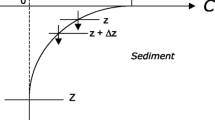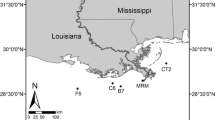Abstract
Streams and rivers are key sources of nitrous oxide (N2O), which is a powerful greenhouse gas. Incomplete denitrification results in N2O production, which is controlled by nitrate (NO3−-N) and organic carbon (C) availability, as well as water temperature. Yet, few studies have experimentally isolated these drivers, especially in lotic systems. We used sediment core incubations conducted at 15 and 25 °C and membrane inlet mass spectrometry to understand how NO3−-N, C, and temperature influence N2O production rates and yields (as %) from sediment denitrification. In general, conditions that enhanced denitrification rates also increased N2O production. At both temperatures, we observed higher N2O production with added C, which was contrary to previous studies, and rates remained high across the NO3−-N gradient at 25 °C. Thus, as global temperatures warm and organic C availability increases in streams and rivers, N2O production from incomplete denitrification in alluvial plain riverine sediments will likely increase.





Similar content being viewed by others
Data availability
The datasets generated during the current study are available from the corresponding author on reasonable request.
References
Alexander RB, Smith R, Schwarz GE et al (2008) Differences in phosphorus and nitrogen delivery to the Gulf of Mexico from the Mississippi River Basin. Environ Sci Technol 42:822–830. https://doi.org/10.1021/es0716103
Attermeyer K, Harjung A, Schelker J, Weigelhofer G (2022) Experimental evaluation of the role of inorganic phosphorus for terrestrial carbon degradation in stream hyporheic zones. Freshw Biol 67:1873–1888. https://doi.org/10.1111/fwb.13980
Baulch HM, Schiff SL, Maranger R, Dillon PJ (2011) Nitrogen enrichment and the emission of nitrous oxide from streams. Glob Biogeochem Cycles 25:253. https://doi.org/10.1029/2011GB004047
Baulch HM, Dillon PJ, Maranger R et al (2012) Night and day: short-term variation in nitrogen chemistry and nitrous oxide emissions from streams. Freshw Biol 57:509–525. https://doi.org/10.1111/j.1365-2427.2011.02720.x
Beaulieu JJ, Tank JL, Hamilton SK et al (2011) Nitrous oxide emission from denitrification in stream and river networks. Proc Natl Acad Sci USA 108:214–219. https://doi.org/10.1073/pnas.1011464108
Betlach MR, Tiedje JM (1981) Kinetic explanation for accumulation of nitrite, nitric oxide, and nitrous oxide during bacterial denitrification. Appl Environ Microbiol 42:1074–1084
Boyero L, Pearson RG, Gessner MO et al (2011) A global experiment suggests climate warming will not accelerate litter decomposition in streams but might reduce carbon sequestration. Ecol Lett 14:289–294. https://doi.org/10.1111/j.1461-0248.2010.01578.x
Canfield DE, Glazer AN, Falkowski PG (2010) The evolution and future of earth’s nitrogen cycle. Science 330:192–196. https://doi.org/10.1126/science.1186120
Cavigelli MA, Robertson GP (2000) The functional significance of denitrifier community composition in a terrestrial ecosystem. Ecology 81:1402–1414. https://doi.org/10.1890/0012-9658(2000)081[1402:TFSODC]2.0.CO;2
Clough TJ, Buckthought LE, Casciotti KL et al (2011) Nitrous oxide dynamics in a Braided River System, New Zealand. J Environ Qual 40:1532–1541. https://doi.org/10.2134/jeq2010.0527
Cole JJ, Caraco NF (2001) Emissions of nitrous oxide (N2O) from a tidal, freshwater river, the Hudson River, New York. Environ Sci Technol 35:991–996. https://doi.org/10.1021/es0015848
Dee MM, Tank JL (2020) Inundation time mediates denitrification end products and carbon limitation in constructed floodplains of an agricultural stream. Biogeochemistry. https://doi.org/10.1007/s10533-020-00670-x
Duan SW, Kaushal SS (2013) Warming increases carbon and nutrient fluxes from sediments in streams across land use. Biogeosciences 10:1193–1207. https://doi.org/10.5194/bg-10-1193-2013
Ferreira V, Chauvet E (2011) Future increase in temperature more than decrease in litter quality can affect microbial litter decomposition in streams. Oecologia 167:279–291. https://doi.org/10.1007/s00442-011-1976-2
Firestone MK, Davidson EA (1989) Microbiologial basis of NO and N2O production and consumption in soil. In: Andreae M, Schimel D (eds) Exchange of trace gases between terrestrial ecosystems and the atmosphere. Wiley, New York, pp 7–21
Fork ML, Heffernan JB (2014) Direct and indirect effects of dissolved organic matter source and concentration on denitrification in northern Florida rivers. Ecosystems 17:14–28. https://doi.org/10.1007/s10021-013-9705-9
García-Ruiz R, Pattinson SN, Whitton BA (1998) Denitrification and nitrous oxide production in sediments of the Wiske, a lowland eutrophic river. Sci Total Environ 210–211:307–320. https://doi.org/10.1016/S0048-9697(98)00020-5
Gardner JR, Fisher TR, Jordan TE, Knee KL (2016) Balancing watershed nitrogen budgets: accounting for biogenic gases in streams. Biogeochemistry 127:231–253. https://doi.org/10.1007/s10533-015-0177-1
Genthner FJ, Marcovich DT, Lehrter JC (2013) Estimating rates of denitrification enzyme activity in wetland soils with direct simultaneous quantification of nitrogen and nitrous oxide by membrane inlet mass spectrometry. J Microb Biochem Technol 5:95–101. https://doi.org/10.4172/1948-5948.1000108
Grant SB, Azizian M, Cook P et al (2018) Factoring stream turbulence into global assessments of nitrogen pollution. Science 359:1266–1269
Griffiths NA, Tank JL, Royer TV et al (2009) Rapid decomposition of maize detritus in agricultural headwater streams. Ecol Appl 19:133–142. https://doi.org/10.1890/07-1876.1
Groffman PM, Altabet MA, Böhlke JK, Butterbach-bahl K, Mark B, Firestone MK, Giblin AE, Kana TM, Nielsen LP, Mary A, Applications SE, Dec N, Bohlke JK, David MB, Voytek MA (2006) Methods for measuring denitrification : diverse approaches to a difficult problem. Ecol Appl 16:2091–2122
Jabiol J, Gossiaux A, Lecerf A et al (2020) Variable temperature effects between heterotrophic stream processes and organisms. Freshw Biol 65:1543–1554. https://doi.org/10.1111/fwb.13520
Kana TM, Darkangelo C, Hunt MD et al (1994) Membrane inlet mass spectrometer for rapid high-precision determination of N2, O2, and Ar in environmental water samples. Anal Chem 66:4166–4170. https://doi.org/10.1021/ac00095a009
Knowles R (1982) Denitrification. Microbiol Rev 46:43–70. https://doi.org/10.1016/0968-0004(76)90171-7
Maag M, Vinther FP (1996) Nitrous oxide emission by nitrification and denitrification in different soil types and at different soil moisture contents and temperatures. Appl Soil Ecol 4:5–14
Nifong RL, Taylor JM, Moore MT (2019) Mulch-derived organic carbon stimulates high denitrification fluxes from agricultural ditch sediments. J Environ Qual 48:476–484. https://doi.org/10.2134/jeq2018.09.0341
O’Brien JM, Dodds WK (2008) Ammonium uptake and mineralization in prairie streams: chamber incubation and short-term nutrient addition experiments. Freshw Biol 53:102–112. https://doi.org/10.1111/j.1365-2427.2007.01870.x
Pfenning KS, McMahon PB (1996) Effect of nitrate, organic carbon, and temperature on potential denitrification rates in nitrate-rich riverbed sediments. J Hydrol 187:283–295
Quick AM, Reeder WJ, Farrell TB et al (2016) Controls on nitrous oxide emissions from the hyporheic zones of streams. Environ Sci Technol 50:11491–11500. https://doi.org/10.1021/acs.est.6b02680
Quick AM, Reeder WJ, Farrell TB et al (2019) Nitrous oxide from streams and rivers: a review of primary biogeochemical pathways and environmental variables. Earth Sci Rev 191:224–262. https://doi.org/10.1016/j.earscirev.2019.02.021
R Core Team (2019) R: A language and environment for statistical computing. R Found Stat Comput, Vienna. https://www.R-project.org/
Reisinger AJ, Tank JL, Hoellein TJ, Hall RO (2016) Sediment, water column, and open-channel denitrification in rivers measured using membrane-inlet mass spectrometry. J Geophys Res Biogeosci 121:1258–1274. https://doi.org/10.1002/2015JG003261
Rosamond MS, Thuss SJ, Schiff SL (2012) Dependence of riverine nitrous oxide emissions on dissolved oxygen levels. Nat Geosci 5:715–718. https://doi.org/10.1038/ngeo1556
Segatto PL, Battin TJ, Bertuzzo E (2020) Modeling the coupled dynamics of stream metabolism and microbial biomass. Limnol Oceanogr 65:1573–1593. https://doi.org/10.1002/lno.11407
Seitzinger SP (1988) Denitrification in freshwater and coastal marine ecosystems: ecological and geochemical significance. Limnol Oceanogr 33:702–724
Seitzinger SP, Kroeze C (1998) Global distribution of nitrous oxide production and N inputs in freshwater and coastal marine ecosystems. Glob Biogeochem Cycles 12:93–113. https://doi.org/10.1029/97GB03657
Silvennoinen H, Liikanen A, Torssonen J et al (2008a) Denitrification and N2O effluxes in the Bothnian Bay (northern Baltic Sea) river sediments as affected by temperature under different oxygen concentrations. Biogeochemistry 88:63–72. https://doi.org/10.1007/s10533-008-9194-7
Silvennoinen H, Liikanen A, Torssonen J et al (2008b) Denitrification and nitrous oxide effluxes in boreal, eutrophic river sediments under increasing nitrate load: a laboratory microcosm study. Biogeochemistry 91:105–116. https://doi.org/10.1007/s10533-008-9262-z
Šimek M, Jíšová L, Hopkins DW (2002) What is the so-called optimum pH for denitrification in soil? Soil Biol Biochem 34:1227–1234. https://doi.org/10.1016/S0038-0717(02)00059-7
Sobczak WV, Findlay S, Dye S (2003) Relationships between DOC bioavailability and nitrate removal in an upland stream: an experimental approach. Biogeochemistry 62:309–327. https://doi.org/10.1023/A:1021192631423
Soued C, Del Giorgio PA, Maranger R (2016) Nitrous oxide sinks and emissions in boreal aquatic networks in Quebec. Nat Geosci 9:116–120. https://doi.org/10.1038/ngeo2611
Speir SL, Taylor JM, Scott JT (2017) Seasonal differences in relationships between nitrate concentration and denitrification rates in ditch sediments vegetated with rice cutgrass. J Environ Qual 46:1500–1509. https://doi.org/10.2134/jeq2016.11.0450
Stow CA, Walker JT, Cardoch L et al (2005) N2O emissions from streams in the Neuse River Watershed, North Carolina. Environ Sci Technol 39:6999–7004. https://doi.org/10.1016/j.watres.2016.05.091
Taylor JM, Lizotte RE, Testa S (2019) Breakdown rates and associated nutrient cycling vary between novel crop-derived and natural riparian detritus in aquatic agroecosystems. Hydrobiologia 827:211–224. https://doi.org/10.1007/s10750-018-3766-x
Taylor JM, Lizotte RE, Testa S, Dillard KR (2017) Habitat and nutrient enrichment affect decomposition of maize and willow oak detritus in Lower Mississippi River Basin bayous. Freshw Sci 36:713–725. https://doi.org/10.1086/694452
Tiedje JM (1988) Ecology of denitrification and dissimilatory nitrate reduction to ammonium. In: Zehnder A (ed) Environmental microbiology of anaerobes. Wiley, New York, pp 179–244
Turner RE, Rabalais NN (2003) Linking landscape and water quality in the Mississippi River Basin for 200 years. Bioscience 53:563. https://doi.org/10.1641/0006-3568(2003)053[0563:LLAWQI]2.0.CO;2
Turner PA, Griffis TJ, Baker JM et al (2016) Regional-scale controls on dissolved nitrous oxide in the Upper Mississippi River. Geophys Res Lett 43:4400–4407. https://doi.org/10.1002/2016GL068710.Received
Veraart AJ, Klein JJM, De, Scheffer M (2011) Warming can boost denitrification disproportionately due to altered oxygen dynamics. PLoS ONE 6:e18508. https://doi.org/10.1371/journal.pone.0018508
Wanders N, van Vliet MT, Wada Y et al (2019) High-resolution global water temperature modeling. Water Resour Res 55:2760–2778. https://doi.org/10.1029/2018WR023250
Wuebbles DJ (2009) Nitrous oxide: no laughing matter. Science 326:56–57. https://doi.org/10.1126/science.1179571
Yao Y, Tian H, Shi H et al (2020) Increased global nitrous oxide emissions from streams and rivers in the Anthropocene. Nat Clim Change 10:138–142. https://doi.org/10.1038/s41558-019-0665-8
Yasarer L, Bingner R, Garbrect J et al (2017) Climate change impacts on runoff, sediment, and nutrient loads in an agricultural watershed in the Lower Mississippi River Basin. Appl Eng Agric 33:379–392
Zarnetske JP, Haggerty R, Wondzell SM, Baker MA (2011) Labile dissolved organic carbon supply limits hyporheic denitrification. J Geophys Res Biogeosci. https://doi.org/10.1029/2011JG001730
Acknowledgements
This research was supported by a University of Notre Dame Graduate School Professional Development Award (GSPDA) and the Center for Environmental Science and Technology (CEST) Predoctoral Research Fellowship awarded to SLS. We thank Sam Testa and Aleesa Bryant of the USDA-ARS National Sedimentation Lab for their assistance in field campaigns and experimental incubations. We also thank Ursula Mahl, Abagael Pruitt, Abigail White, Ally Mars, and Jacob Fries for their assistance in laboratory efforts at the University of Notre Dame. All MIMS and DOC analyses were conducted at CEST at the University of Notre Dame.
Funding
This study was supported by a University of Notre Dame Graduate School Professional Development Award and the Center for Environmental Science and Technology, University of Notre Dame.
Author information
Authors and Affiliations
Contributions
SLS lead the manuscript effort and developed the research questions. SLS, JLT, and JMT designed the study approach. SLS, JMT, and ALG carried out both field campaigns and the laboratory experiments. SLS analyzed all nutrient and dissolved gas samples. SLS wrote the original manuscript draft. JLT, JMT, and ALG reviewed and edited several manuscript drafts.
Corresponding author
Ethics declarations
Competing interests
The authors have no relevant financial or non-financial competing interests to disclose.
Additional information
Responsible Editor: Samantha R Weintraub-Leff.
Publisher’s Note
Springer Nature remains neutral with regard to jurisdictional claims in published maps and institutional affiliations.
Supplementary Information
Below is the link to the electronic supplementary material.
Rights and permissions
Springer Nature or its licensor (e.g. a society or other partner) holds exclusive rights to this article under a publishing agreement with the author(s) or other rightsholder(s); author self-archiving of the accepted manuscript version of this article is solely governed by the terms of such publishing agreement and applicable law.
About this article
Cite this article
Speir, S.L., Tank, J.L., Taylor, J.M. et al. Temperature and carbon availability interact to enhance nitrous oxide production via denitrification in alluvial plain river sediments. Biogeochemistry 165, 191–203 (2023). https://doi.org/10.1007/s10533-023-01074-3
Received:
Accepted:
Published:
Issue Date:
DOI: https://doi.org/10.1007/s10533-023-01074-3




